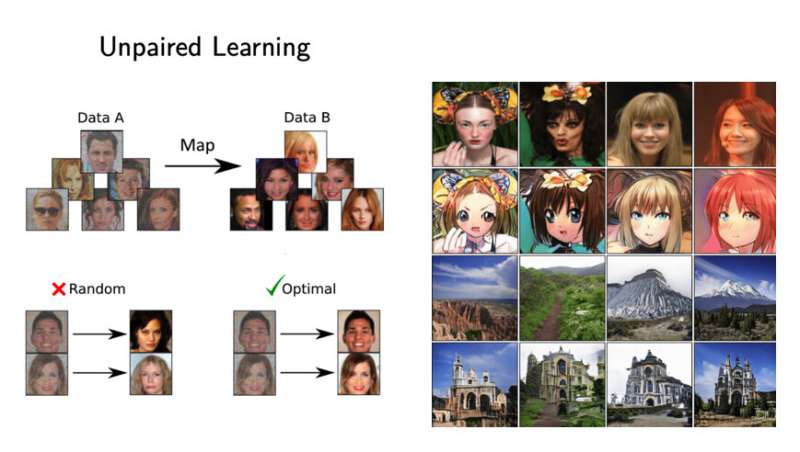
Researchers from Skoltech and the Artificial Intelligence Research Institute (AIRI) have developed a new algorithm for optimal data transfer between domains using neural networks. Unlike most similar techniques, the new method does not require paired training datasets, such as input-output samples, and can be trained on independent datasets from the input and output domains. The algorithm produces a more interpretable result than other existing approaches and rests on a solid theoretical foundation.
Modern machine learning models designed for applications such as face or speech recognition and medical image analysis require large training datasets that are hard to get. It is for this reason that researchers and engineers have to create synthetic data matching those available in reality. The task is largely facilitated by generative models which have recently made tremendous progress in terms of text and image quality.
Generative models help synthesize data from other data, in other words, move one domain into another. For example, a neural network can create a digital picture from a sketch drawn by a human or enhance fine details in a satellite image. These tasks typically require paired training samples and input-output image sets that a neural network learns to generalize and extend to new incoming images, which helps deal with several identical images of different quality, among other things.
Since paired data is usually very expensive or hard to get, researchers have to make do with independent datasets, which makes it more difficult to achieve a good result.
“Standard approaches to building generative models for domain transfer are largely heuristic and dependent on multiple hyperparameters that affect training results and are not easily selectable. Moreover, such approaches lack a mathematically rigorous framework. As a consequence, model training is an unstable process that you have to adjust manually. Unsurprisingly, rigorous theoretical conclusions about the training outcomes are also hard to obtain,” Professor Evgeny Burnaev, Skoltech’s AI director and a research team lead at AIRI, commented.
In its research, the team revisited the works of the Soviet mathematician and economist Leonid Kantorovich and used his ideas about optimal cargo transportation (the optimal transport theory) to create a new algorithm for planning optimal data transport between domains. The new algorithm, called Neural Optimal Transport, uses deep neural networks and independent datasets.
When tested on unpaired domain transfer, the algorithm outperforms the existing methods in several tasks, including image styling. Moreover, unlike other techniques, it needs fewer hyperparameters, which are usually difficult to tune, produces a more interpretable result, and rests on a solid mathematical foundation.
“Optimal transport numerical methods have been widely used for several years to build generative neural networks. Our exploratory research showed that these models calculate optimal transport with a very high error. We have managed not only to find the reasons for the error, but also to perform analysis and develop fundamentally new effective ways to build generative models for unpaired domain transfer based on optimal transport theory,” Alexander Korotin, an AIRI research scientist and Skoltech research team lead, said.
The research is published on the arXiv preprint server.
More information:
Alexander Korotin et al, Neural Optimal Transport, arXiv (2022). DOI: 10.48550/arxiv.2201.12220
Citation:
Scientists achieve optimal interdomain data transfer using neural networks (2023, April 7)
retrieved 8 April 2023
from https://techxplore.com/news/2023-04-scientists-optimal-interdomain-neural-networks.html
This document is subject to copyright. Apart from any fair dealing for the purpose of private study or research, no
part may be reproduced without the written permission. The content is provided for information purposes only.
Stay connected with us on social media platform for instant update click here to join our Twitter, & Facebook
We are now on Telegram. Click here to join our channel (@TechiUpdate) and stay updated with the latest Technology headlines.
For all the latest Technology News Click Here
